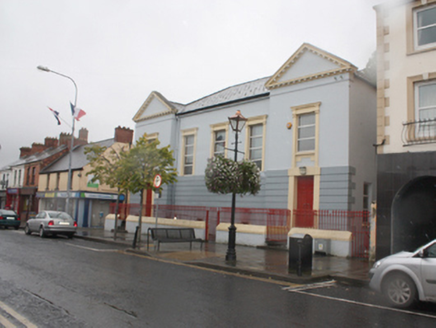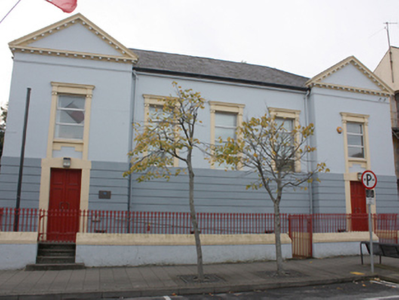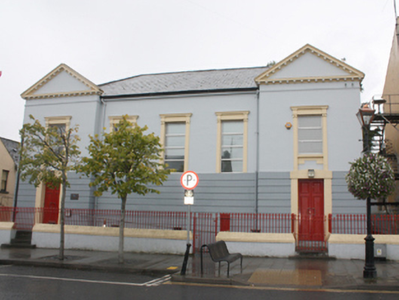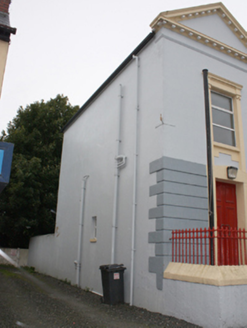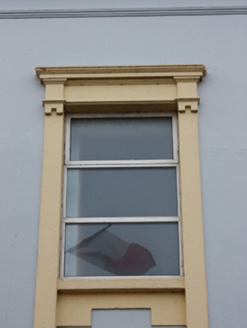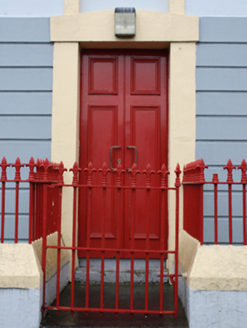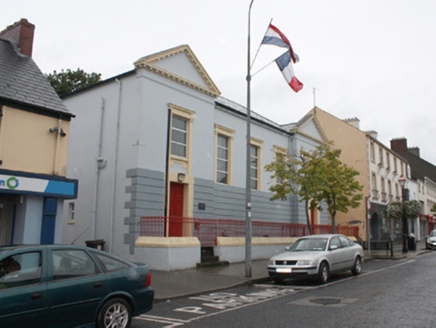Survey Data
Reg No
40815039
Categories of Special Interest
Architectural, Historical, Social
Original Use
Court house
Historical Use
Library/archive
In Use As
Court house
Date
1840 - 1850
Coordinates
234920, 431998
Date Recorded
09/09/2008
Date Updated
--/--/--
Description
Detached five-bay two-storey over basement courthouse, built 1839-42 and refurbished 1925, having advanced pedimented bays to either end of the front elevation (east), and with single-bay single-storey addition to the rear (west). Formerly also in use as a jail (basement level), and later as a public library. Hipped artificial slate roof to main body of building with grey clayware ridge tiles, and profiled cast-iron rainwater goods; pitched natural and artificial slate roofs to advanced pedimented bays with modillions to pediments. Channelled smooth rendered walls at ground floor level with smooth rendered walls over at first floor level, and having render cornice stringcourse over first floor openings. Square-headed window openings with rendered surrounds with rendered entablatures over, and with replacement windows. Square-headed door openings to end bays having smooth rendered surrounds, and double leaf timber panelled doors. Double-height courtroom to interior with panelled timber dock, fixed timber bench seating, reredos to judge’s chair, and gallery supported on cast-iron columns. Set slightly back from road to the centre of Buncrana. Rendered boundary walls to road-frontage to the east having painted pyramidal coping and cast-iron railings over with fleur-de-lys finials. Cast-iron gates to entrances. High rubble stone wall to the rear (west).
Appraisal
This fine mid nineteenth-century classical-style courthouse retains its early form and character. Its central location to the centre of Buncrana, and the subdued classical detailing such as the pedimented end bays and the entablatures to the window openings, give this building a strong presence and air of authority that befits an important civic building such as a courthouse. The loss of the original window fittings, although regrettable, fails to detract substantially from its architectural integrity. There was formerly a bridewell (jail) to the basement level, later converted to public toilets, while there was a library here in recent decades. The interior retains some interesting timber joinery, which may be a later addition (see below). Its plan and form are similar to a number of courthouses built in some of the smaller regional towns in Ireland during the mid-nineteenth century, including that at Glenties in Donegal (which was probably built to designs by William Caldbeck in 1842), at Listowel in Kerry, Newcastle West in Limerick, Youghal in Cork, and it is similar to that at Carndonagh (see 40805024) to the north end of Inishowen. It may have been built to designs by William Calbeck (1824-72) based on stylistic similarities with other courthouses he designed. However, it has also been suggested that it may be by Jacob Owen (1778-1870), an engineer and architect with the Board of Public Works from 1832-56. The Board of Public Works advanced a loan of £950 towards the cost of the construction of this courthouse in 1842. Slater's Directory of 1881 records that petty sessions took place here every alternate Thursday. The courthouse was later damaged during the War of Independence or the Civil War, a fate suffered by many buildings of its type throughout Ireland between 1919 and 1923, and was later 'reconstructed' in 1925 by William James Doherty (1887-1951), an architect from Derry City who worked extensively in County Donegal from the 1920s. Occupying a prominent site in the centre of Buncrana, this building is a notable and imposing feature in the streetscape of the town, and an integral element of the built heritage of the local area. The attractive cast-iron railings and gates to the street-frontage to the east, and the rubble stone boundary wall to the rear, complete this composition and add to the setting. As an important public building within the town, this courthouse is a structure of merit, not simply for its impressive architectural design, but because it represents historical and social significance to the local area.
